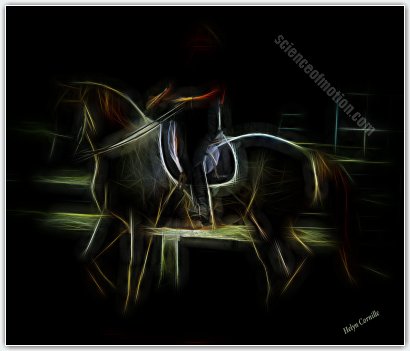Questioning Answers
Questioning Answers
Jean Luc Cornille

“I would rather have questions that can’t be answered than answers which can’t be questioned.” (Richard Feynman)
Since the conception of the classical school of riding, there have been questions that the knowledge of equine locomotion available at the time, could not answer. They were answered based on visual impression, feeling, experience, and the answers became dogmas that could not be questioned.
For instance, old school of thought, believes that the deep engagement of the hind legs forward under the belly, allows the hind legs to propel the body upward and forward. Measurements made in 1993 demonstrated that, “In horses, and most other mammalian quadrupeds, 57% of the vertical impulse is applied through the thoracic limbs, and only 43% through the hind limbs.” (H. W. Mertens, H. C. Schamhardt,G. J. van Osch, A. J. van den Bogert, 1993). At impact, and during almost the first half of the stride, the alighting hind leg decelerates the horse’s body resisting attraction of gravity and inertia forces. The propulsive activity commences as the leg is moving back behind the body. The net effect is therefore, a force in the direction of the motion, and not upward self-carriage, as our ancestors believed.
While deep engagement of the alighting hind leg is beneficial to store elastic strain energy in tendons, fascia, ligaments, aponeurosis and muscles, the mastery of balance is a forward phenomenon based on the capacity of the back muscles to convert the horizontal thrust generated by the hind legs into upward forces. “An initial thrust on the column is translated into a series of predominantly vertical and horizontal forces which diminish progressively as they pass from one vertebra to the next”. (Richard Tucker, Contribution to the Biomechanics of the vertebral Column, Acta Thoeriologica, VOL. IX, 13: 171-192, BIALOWIEZA, 30. XL. 1964). The old belief that balance can be achieved shifting the weight backward over the haunches does not stand in front of actual understanding of equine locomotion. “This notion that is still in use today does not have any scientific meaning from the perspective of the equine biological mechanism” (Sophie Biau – PhD thesis. 2002).
The solution to this problem is therefore upgrading riding and training principles to actual knowledge. This is where answers that cannot be questioned forbid today’s athletes, equine as well as humans, to benefit from actual knowledge. There are 186 synovial articulations in the equine vertebral column. Considering that major articulations have two facets and accessory articular surfaces, there are 344 articular surfaces in the equine spine. They have different degrees of motion at different areas of the spine. The muscles surrounding the vertebrae have a large diversity of elastic stiffness. The spine is capable of a very large variety of movements occurring within a limited range of motion, and the equestrian literature wants us to believe that this highly complex system is controlled by pectoral and abdominal muscles. The theory is asking to the horse to write a PhD thesis with kindergarten insights.
Already in 1990, Nancy Deuel observed that talented Olympic dressage horses prepared their body for greater mastery of balance and power, during the stride preceding the flying change, increasing the duration of the hind legs ground contact. “The higher-scoring horses increased contact duration of the hind limbs and decreased the length of step and time between forelimb impacts to prepare to execute the lead change in the succeeding airborne phase.” (Nancy Deuel Ph.D. -1990) Later, J. L. Morales explained that such increased contact duration of the hind limbs allowed greater storage and use of elastic energy helping the horse to deal with the athletic demand of the performance and the load of the rider. “It should be borne in mind that the weight of the rider will rise two- or three-fold during locomotion and also that more energy is required by a mounted horse and this energy must be obtained by increasing the stance phase so as to recover more energy during the swing.” (J. L. Morales, DVM, PhD, 1998)
As long as we do not question, in the light of actual knowledge, answers made when knowledge of equine dynamics and kinematics was in its infancy, we expose the horse to performances for which the horse’s physique is not adequately prepared, and therefore, executions (of movements) below the horse’s potential and only for a short laps of time before lameness.
Jean Luc
Editor-Susan Hopf
Learn about our online and DVD course


 twitter
twitter facebook
facebook google
google pinterest
pinterest linkedin
linkedin